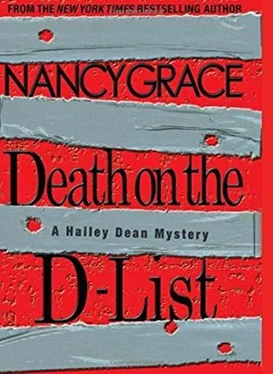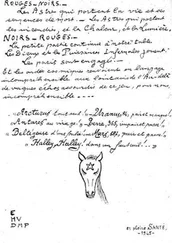She was also plumbed for running water, too. Nice.
Several faucets and spigots running along the width of the table facilitated rinsing away the copious amounts of blood released during the procedure. Blood flowed by the quart, depending on the mode of death, of course, down into long, slender receptacles unobtrusively located at the edges of the table.
This particular sweetie was basically a tray, slanted for drainage. And it had slightly raised edges, preventing blood and other bodily fluids from spilling onto the floor.
Without much preamble, Davis pulled his long, dark hair into a ponytail, secured a surgeon’s cap over it, and flicked on one of the intense overhead lights above the autopsy slab. Taking a cursory look up and down the body, he inhaled deeply through his nose, breathing in the heavy smell of the woman’s bloody leotard.
Emory Davis loved his job.
Cutting through the skimpy Danskin with a surgical knife, the autopsy began. He started speaking cordially but routinely into a handheld microphone, taping for the record the COD, formally pronouncing cause of death.
“Well-nourished Caucasian female, brunette, approximately thirty to thirty-five years of age, sixty-five inches in length.”
Hmm. No personal effects like a purse with a wallet and driver’s license inside to check the date of birth. He’d have to guesstimate the age. He was usually right-on with all of it at the first guess… age, weight, height.
He clicked off the recorder and pulled out his measuring tape. Just to double-check. He quickly extended the yellow ribbon from the top of her head, what was left of it, to the bottom of her heel.
His first guess was right. Five-five.
It was a little game he’d created all alone back in one of the morgues where he’d interned in med school. He guessed the exact length of corpses. It was amazing the acumen you could develop after years of dead bodies.
Well-nourished was a stretch. This girl needed to eat. “Well-nourished” was a term of art to indicate that starvation was not the cause of death and that the body was within the acceptable weight parameters for height. And those parameters were wide, indeed. Emory guessed this was just another anorexic New York woman who lived off drinking Perrier and picking at salads.
“Weight, one hundred pounds.” Davis continued speaking into the handheld mike, detailing the autopsy as he went along. The overhead hot light bored into the brick-brown blood caked around the victim’s neck.
He punched a button on the side of the autopsy table, rigged with automatic scales. The digital number shone dull red. Emory smiled. Dead on… again. A hundred pounds on the nose.
“Single shot to the head. Near-decapitation of victim suggests to this doctor subject is the victim of homicide.”
Of course it was homicide. He’d spent nearly six months in med school in a class titled Methods and Assessment of Homicide and Suicide. Statistically speaking, no way would a white female of this age, and judging by the expensive jewelry, this income bracket, shoot herself in the face.
Maybe it was vanity or just pure instinct, but rarely did women shoot themselves, much less in the head, in order to off themselves. They usually went the pill-overdose-mixed-with-booze route, maybe gas from the car or oven; and sometimes he’d get a jumper; but shooting to the head?
Nope. It was homicide for sure.
Plus, there was the obvious trajectory, the path of the bullet or bullets.
That spoke volumes.
Emory paused to whip out the Polaroid camera from the lower shelf of the metal side table again, taking close-ups of the head wound. He had to take photos, even if a jury wouldn’t be able to discern what they were seeing amid the bloody pink tissue in the Polaroid close-up.
Suddenly he stopped. There was something familiar about this autopsy. It was like déjà vu. He’d done it before.
Of course, he’d performed literally thousands of autopsies, but it wasn’t that. It wasn’t the repetitive nature of the autopsy. He suddenly had the intense sensation he’d done this exact autopsy of this exact woman before. Since Emory believed in nothing other than that proven by science, he shook it off and continued narrating.
Practically poking his nose into the woman’s skull, he observed the gunshot wound had left her left temporal lobe totally exposed. Taking a close look, Emory continued narrating into the handheld.
“Bullet entry wound is through the deceased’s cranium, left temple entry, angle front to back, direction is left to right, at a mildly lowered angle, from up to down. Bullet exiting victim’s head just below and behind right ear.”
He went back to document details of the entry wound. Carefully looking at the bullet’s entry, Emory detected stippling, the gunshot residue, and markings on the skin. He spoke again into the handheld. “Stippling noted in and around the entry wound with maroon-tinted particles, likely part of the gunshot debris.” He continued to make his way along the bullet’s path.
Emory looked intensely, barely breathing. He delicately pulled away layers of brain matter as fine as tissue paper to precisely confirm the exact trajectory path, although a look at the outside of the head normally tells all. Based simply on bullet entry and exit wound locations, here, the entry wound was a huge, gaping hole, not a clean and tidy entry at all. Emory would have to burrow further into the head to get the exact angle. Details matter.
“Neither bullet nor bullet fragmentation is observed anywhere within the brain cavity or for that matter, within the entire cranium itself.”
Wait. Without moving his head or averting his gaze to look up, Emory reached above himself and pulled down the bright retractable light hanging over the table. It was hot to the touch, and getting hotter by the moment.
There it was. Deeply embedded in brain tissue, he saw it.
A tiny, tiny metallic fragment. It had clearly splintered off upon impact with the skull. Disturbing the least amount of tissue possible, Emory reached over to the steel surgical tray he’d placed directly at his right elbow to grab a pair of tweezers.
Carefully, carefully, barely breathing, with the thin pair of tweezers, he plucked the speck of metal from her brain. Placing it in a tiny Zip Lock bag designed specifically for this purpose, Emory finally exhaled deeply, and then inhaled. The surgical smell of the room, combined with the tiniest whiff signaling the inception of human decomposition, didn’t bother Emory in the least.
He did it. Many, if not most, doctors would have missed the fragment. It was extremely important, possibly crucial to the case.
If the fragment was not damaged beyond medical and forensic use, it could be analyzed at the crime lab. Actually, Emory could pretty much call the caliber of a sliver of fragment himself, but best to leave it to the experts in ballistics at the lab.
From the sliver, caliber could be determined and possibly traced to a specific handgun if that particular handgun’s tool markings were registered in the national database.
The database, The Integrated Ballistics Identification System (IBIS), is a highly specialized computer program that compares markings on crime scene bullets to those in other cases. It accesses a database maintained by ATF, the Bureau of Alcohol, Tobacco, Firearms, and Explosives.
IBIS would scan the bullet for markings, then run those markings against a database of known weapons to identify matches that police and crime technicians might never have identified. Who knew if there was enough bullet to get a match, but at least Emory had done his part.
Good thing he taped his narration before dedicating it to writing for the formal autopsy report. He rewound and played it back, listening to his own words. “Neither bullet nor bullet fragmentation is observed anywhere within the brain cavity or for that matter, within the entire cranium itself.”
Читать дальше












